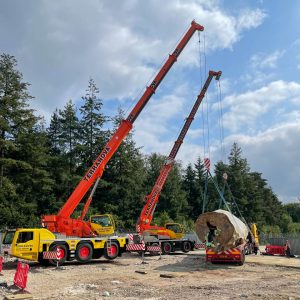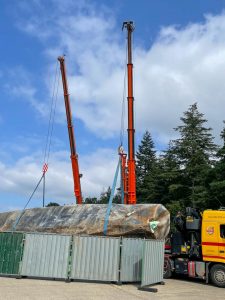 We successfully completed a multi-crane lift using our Challenger 3160 and Demag AC45 this week for the Ministry of Defence. They required a large fuel tank to be removed from its current location at Minley in Hampshire so it could be safely scrapped.
We successfully completed a multi-crane lift using our Challenger 3160 and Demag AC45 this week for the Ministry of Defence. They required a large fuel tank to be removed from its current location at Minley in Hampshire so it could be safely scrapped.
For this lift, we used two cranes along with our knowledge and skills to get the job safely completed at the time required.
During a multi-crane lift good coordination is essential to avoid overloading either the cranes or their rigging. If one crane lifts its end more than its partner(s), the load distribution can become dangerously unbalanced and result in unwanted horizontal forces. The closer a crane is to the centre of gravity for a load, the more loading force that crane will receive. For a multi-crane lift, knowing where the load’s centre of gravity will be throughout the entire lift is critical to a safe lift. For this dual lift, each crane and rig could safely lift more than 20% of their calculated share of the load.
There are many reasons to do a multi-crane lift, a heavier load than the Maximum Rated Capacity of a single crane, greater load distribution over a load bearing surface, greater reach than is possible with a single crane for a heavy load, the physical size of a load, the structural strength of a load, and finally, a need to rotate the load during the lift.







